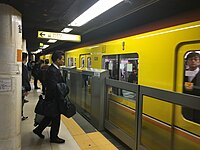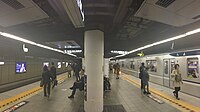Ginza Station (銀座駅, Ginza-eki) is a subway station in Chūō, Tokyo, Japan, operated by the Tokyo subway operator Tokyo Metro. It serves the Ginza commercial district, and is the fourth-busiest Tokyo Metro station after Ikebukuro, Ōtemachi, and Kita-senju.[1]
G09 H09 M16 Ginza Station 銀座駅 | ||||||||||||||||||||||||||
|---|---|---|---|---|---|---|---|---|---|---|---|---|---|---|---|---|---|---|---|---|---|---|---|---|---|---|
 ExitA3 and Wako | ||||||||||||||||||||||||||
| General information | ||||||||||||||||||||||||||
| Location | 4-1-2 Ginza, Chuo City, Tokyo Japan | |||||||||||||||||||||||||
| Operated by | ||||||||||||||||||||||||||
| Line(s) | ||||||||||||||||||||||||||
| Platforms | 3 island platforms (1 for each line) | |||||||||||||||||||||||||
| Tracks | 6 (2 for each line) | |||||||||||||||||||||||||
| Connections | Y19 Ginza-itchōme Station | |||||||||||||||||||||||||
| Construction | ||||||||||||||||||||||||||
| Structure type | Underground | |||||||||||||||||||||||||
| Accessible | Yes | |||||||||||||||||||||||||
| Other information | ||||||||||||||||||||||||||
| Station code | G-09, M-16, H-09 | |||||||||||||||||||||||||
| Website | www | |||||||||||||||||||||||||
| History | ||||||||||||||||||||||||||
| Opened | 3 March 1934 | |||||||||||||||||||||||||
| Passengers | ||||||||||||||||||||||||||
| FY2019 | 257,440 daily | |||||||||||||||||||||||||
| Services | ||||||||||||||||||||||||||
| ||||||||||||||||||||||||||
| Location | ||||||||||||||||||||||||||
Lines
Ginza Station is served by the following three Tokyo Metro lines.
- Tokyo Metro Ginza Line (G-09)
- Tokyo Metro Marunouchi Line (M-16)
- Tokyo Metro Hibiya Line (H-09)
Station layout
Each line has an island platform serving two tracks. The Ginza and Marunouchi Line platforms are located separately on the 2nd basement (B2F) level, while the Hibiya Line platforms are located on the 3rd basement (B3F) level.
Platforms
| 1 | G Ginza Line | for Akasaka-mitsuke, Omote-sando, and Shibuya |
| 2 | G Ginza Line | for Nihombashi, Ueno, and Asakusa |
| 3 | M Marunouchi Line | for Yotsuya, Shinjuku, Ogikubo, and Hōnanchō |
| 4 | M Marunouchi Line | for Otemachi, Korakuen, and Ikebukuro |
| 5 | H Hibiya Line | for Roppongi and Naka-meguro |
| 6 | H Hibiya Line | for Ueno and Kita-senju TS Tobu Skytree Line for Tōbu-Dōbutsu-Kōen TN Tobu Nikko Line for Minami-Kurihashi |
The song "Ginza Kankan Musume" (銀座カンカン娘, Ginza Kankan Musume) by Ryōichi Hattori is used as the departure melody on the Ginza Line platforms in 2012.[2]
The song "The Love Story of Ginza" (銀座の恋の物語, Ginza no Koi no Monogatari) by Yujiro Ishihara and Junko Makimura is used as the departure melody on the Hibiya Line platforms in 2016.[3]
- Entry to Ginza Metro station at Sukiyabashi intersection, 2020
- Ginza Line platforms, 2007
- New platform screen doors as used on the Ginza Line platform, 2018
- Marunouchi Line platforms, 2018
- Hibiya Line platforms, 2019
History
Ginza Station opened on the Ginza Line on 3 March 1934.[4] The Marunouchi Line began service to Ginza on 15 December 1957,[4] and the Hibiya Line platforms opened on 29 August 1964.[4]
The station facilities were inherited by Tokyo Metro after the privatization of the Teito Rapid Transit Authority (TRTA) in 2004.[5]
TH Liner services on the Hibiya Line between Ebisu and Kuki commenced on 6 June 2020.[6]
Passenger statistics
In fiscal 2019, the station was used by an average of 257,440 passengers daily.[1]
Surrounding area
An underground passage connects with the following stations, allowing transfer on foot. Ginza-itchōme is the official transfer station, the others are not.
- Ginza-itchōme (Tokyo Metro Yūrakuchō Line)
- Higashi-Ginza (Tokyo Metro Hibiya Line, Toei Asakusa Line)
- Hibiya (Tokyo Metro Hibiya Line, Tokyo Metro Chiyoda Line, Toei Mita Line)
- Yūrakuchō (Tokyo Metro Yūrakuchō Line, Yamanote Line, Keihin-Tōhoku Line)
References
External links

- Ginza station information (Tokyo Metro) (in English)
- Ginza station information (Tokyo Metro) (in Japanese)








